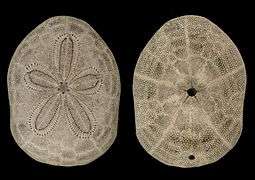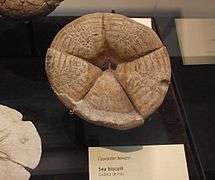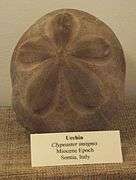Clypeaster
Clypeaster, common name "cake urchins" or "sea biscuits", is a genus of echinoderms belonging to the family Clypeasteridae.
| Clypeaster | |
|---|---|
 | |
| Live Clypeaster reticulatus | |
| Scientific classification | |
| Kingdom: | |
| Phylum: | |
| Class: | |
| Order: | |
| Suborder: | Clypeasterina |
| Family: | |
| Genus: | Clypeaster Lamarck, 1801 |
Etymology
The genus name Clypeaster is derived from the Latin “clypeus” (meaning round shield) and “aster” (meaning star), with reference to the shape of these organisms.
List of Species[1]
- Clypeaster aloysioi (Brito, 1959)
- Clypeaster amplificatus Koehler, 1922
- Clypeaster annandalei Koehler, 1922
- Clypeaster australasiae (Gray, 1851)
- Clypeaster chesheri Serafy, 1970
- Clypeaster cyclopilus H.L. Clark, 1941
- Clypeaster durandi (Cherbonnier, 1959b)
- Clypeaster elongatus H.L. Clark, 1948
- Clypeaster euclastus H.L. Clark, 1941
- Clypeaster europacificus H.L. Clark, 1914
- Clypeaster eurychorius H.L. Clark, 1924
- Clypeaster euryptealus H.L. Clark, 1925
- Clypeaster fervens Koehler, 1922
- Clypeaster humilis (Leske, 1778)
- Clypeaster isolatus Serafy, 1971
- Clypeaster japonicus Döderlein, 1885
- Clypeaster kieri Pawson & Phelan, 1979
- Clypeaster lamprus H.L. Clark, 1914
- Clypeaster latissimus (Lamarck, 1816)
- Clypeaster leptostracon A. Agassiz & H.L. Clark, 1907
- Clypeaster luetkeni Mortensen, 1948
- Clypeaster lytopetalus A. Agassiz & H.L. Clark, 1907
- Clypeaster microstomus Lambert, 1912 †
- Clypeaster miniaceus H.L. Clark, 1925
- Clypeaster minihagali Deraniyagala, 1956 †
- Clypeaster nummus Mortensen, 1948
- Clypeaster ochrus H.L. Clark, 1914
- Clypeaster ohshimensis Ikeda, 1935
- Clypeaster oliveirai Krau, 1952
- Clypeaster pallidus H.L. Clark, 1914
- Clypeaster pateriformis Mortensen, 1948
- Clypeaster prostratus (Ravenel, 1845)
- Clypeaster rangianus Desmoulins, 1835
- Clypeaster rarispinus de Meijere, 1903
- Clypeaster ravenelii (A. Agassiz, 1869)
- Clypeaster reticulatus (Linnaeus, 1758)
- Clypeaster rosaceus (Linnaeus, 1758)
- Clypeaster rotundus (A. Agassiz, 1863)
- Clypeaster speciosus Verrill, 1870
- Clypeaster subdepressus (Gray, 1825)
- Clypeaster telurus H.L. Clark, 1914
- Clypeaster tumidus (Tension-Woods, 1878)
- Clypeaster virescens Döderlein, 1885
Gallery
 Clypeaster reticulatus
Clypeaster reticulatus Fossil of Clypeaster bowersi the San Diego Natural History Museum, California
Fossil of Clypeaster bowersi the San Diego Natural History Museum, California Fossil of Clypeaster insignis at the San Diego County Fair, California
Fossil of Clypeaster insignis at the San Diego County Fair, California Fossil of Clypeaster portentosus at the Museo Arqueológico Municipal de Cartagena
Fossil of Clypeaster portentosus at the Museo Arqueológico Municipal de Cartagena_derivate_2013.jpg)
gollark: I think it was some CC music project.
gollark: I don't have a screenshot of that.
gollark: Please hold on while I investigate the relevant screenshots.
gollark: Also because I forgot to find a time when heav was available for phase π.
gollark: This is why we didn't hire them.
References
- Clypeaster Lamarck, 1801
- Animal Diversity
- National History Museum
- Sepkoski, Jack Sepkoski's Online Genus Database
- Paleobiology Database
This article is issued from Wikipedia. The text is licensed under Creative Commons - Attribution - Sharealike. Additional terms may apply for the media files.